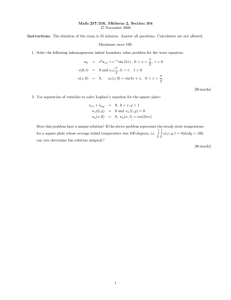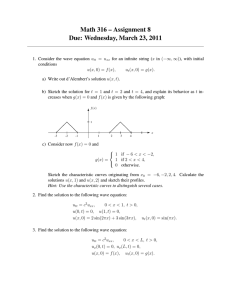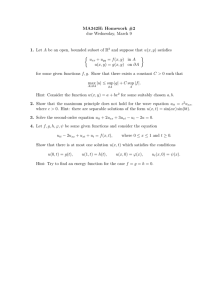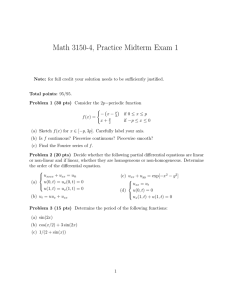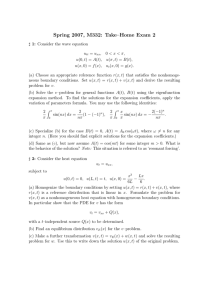Vibrating Strings and Heat Flow
advertisement
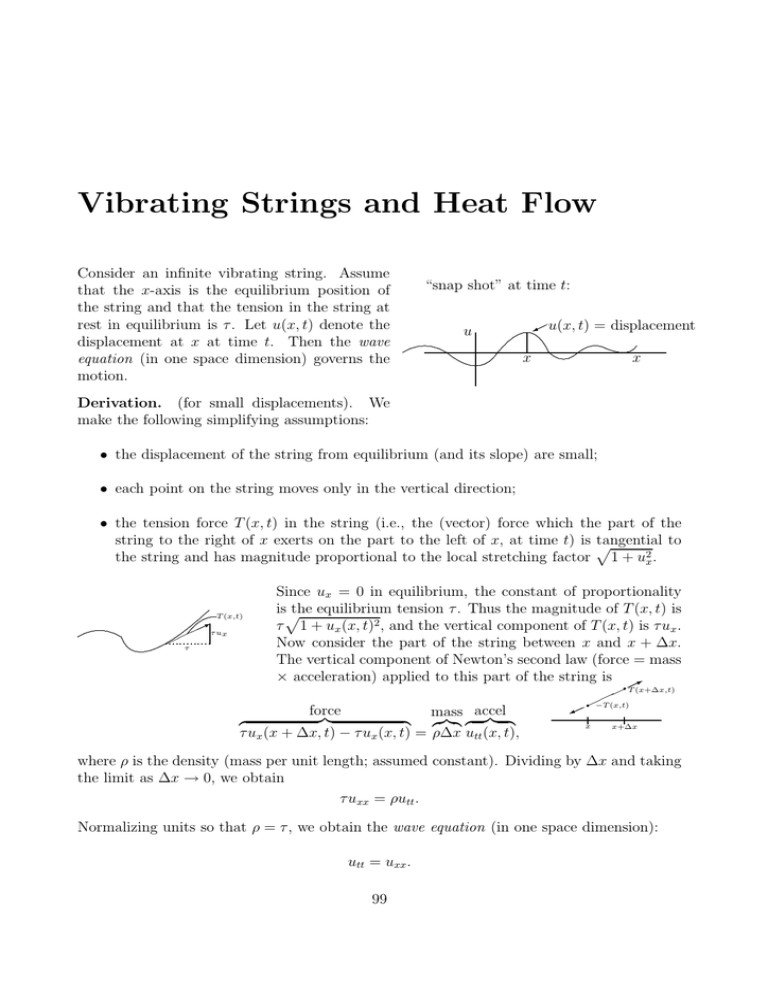
Vibrating Strings and Heat Flow
Consider an infinite vibrating string. Assume
that the x-axis is the equilibrium position of
the string and that the tension in the string at
rest in equilibrium is τ . Let u(x, t) denote the
displacement at x at time t. Then the wave
equation (in one space dimension) governs the
motion.
“snap shot” at time t:
u(x, t)
u
= displacement
....................
.......
....
.....
...
....
...
...
......................
.
.
.
.
.
.
.
.
.
.
...
.
.
.
.
.
...
....................................
.
.
......
..
..
.
........................
....
.....
.
.....
......
.
....
......
..
.....
.
.
.....................
.
......
..
.
.......
.
.
.
........................
x
x
Derivation. (for small displacements). We
make the following simplifying assumptions:
• the displacement of the string from equilibrium (and its slope) are small;
• each point on the string moves only in the vertical direction;
• the tension force T (x, t) in the string (i.e., the (vector) force which the part of the
string to the right of x exerts on the part to the left of x, at time t) is p
tangential to
the string and has magnitude proportional to the local stretching factor 1 + u2x .
..
....
.... .............T (x,t)
...........
...........
.
.
.
........
.............................
........
...........
......
τ ux
......
.....
...
.....
...
......
.
.
.
.
....
.
.
......... .................
τ
..........
*
Since ux = 0 in equilibrium, the constant of proportionality
isp
the equilibrium tension τ . Thus the magnitude of T (x, t) is
τ 1 + ux (x, t)2 , and the vertical component of T (x, t) is τ ux .
Now consider the part of the string between x and x + ∆x.
The vertical component of Newton’s second law (force = mass
× acceleration) applied to this part of the string is *
force
mass accel
}|
{ z}|{ z }| {
z
τ ux (x + ∆x, t) − τ ux (x, t) = ρ∆x utt (x, t),
q T (x+∆x,t)
q −T (x,t)
x
x+∆x
where ρ is the density (mass per unit length; assumed constant). Dividing by ∆x and taking
the limit as ∆x → 0, we obtain
τ uxx = ρutt .
Normalizing units so that ρ = τ , we obtain the wave equation (in one space dimension):
utt = uxx .
99
100
Vibrating Strings and Heat Flow
Solutions of utt = uxx
Change variables. Let y = x + t, z = x − t, so x = 21 (y + z), t = 21 (y − z). Then
∂y = (∂y x) ∂x + (∂y t) ∂t = 21 (∂x + ∂t ) ,
∂z = (∂z x)∂x + (∂z t)∂t = 21 (∂x − ∂t ) ,
so uy = 21 (ux + ut ) and uyz = 21 (∂x − ∂t ) 21 (ux + ut ) = 14 (uxx − utt ). In the new coordinates,
the wave equation becomes simply uyz = 0. Thus uy is independent of Rz, i.e., uy = e
v (y).
Integrating in y for each fixed z, we get u = v(y) + w(z) (where v(y) = ve(y)dy). So any
solution of the wave equation utt = uxx is of the form
(∗)
u(x, t) = v(x + t) + w(x − t).
Physically, this is a superposition of left-going and right-going waves:
v(x)
............
....... ............
....
....
....
....
....
....
....
..
.....
..
...
.....
...
.......
...........................
w(x)
.............................
......
.....
.................
......
.........
..........
..............
......................................
............................
......
.....
.....
.................
..........
........
.
.
.
................
.
.
.
.
.
.
.
.
.
...........................
-
(as t increases)
...........
........ ...........
....
.....
....
....
....
....
.
....
..
.....
...
.....
....
......
.
.
.
.
.
.......................
v(x + t)
w(x − t)
Observation. The derivation above shows that any C 2 function of x and t satisfying the
wave equation is of the form (∗). Conversely, if v and w are C 2 functions of one variable,
it is easily checked that u(x, t) = v(x + t) + w(x − t) is a C 2 solution of the wave equation.
But if v and w are only continuous, v(x + t) + w(x − t) still makes sense; in what sense is
this a solution of utt = uxx ? We will see later in the course that the equation holds in the
sense of distributions.
Initial-Value Problem (IVP) (or the Cauchy Problem)
If we think of the wave operator as an ordinary differential operator in time acting on
functions of t taking values in functions of x (overlooking considerations arising from the
fact that ∂x2 is itself a differential operator), we “should” be able to determine u(x, t) for
x ∈ R and t ≥ 0 if we are given initial values u(x, 0) and ut (x, 0) for x ∈ R (we need u and
ut at t = 0 since the equation is second-order in t).
D’Alembert’s Formula (for the Cauchy Problem for utt = uxx )
Consider the IVP: DE utt = uxx (x ∈ R, t ≥ 0)
u(x, 0) = f (x)
IC
ut (x, 0) = g(x)
(x ∈ R)
(x ∈ R)
101
Vibrating Strings and Heat Flow
(To obtain a C 2 solution u(x, t), it will suffice for f ∈ C 2 (R), g ∈ C 1 (R).) We will separately
analyze the cases g ≡ 0 and f ≡ 0, and then use superposition.
Case 1. g ≡ 0.
IC
u(x, 0) = f (x)
(x ∈ R).
ut (x, 0) = 0
We have u(x, t) = v(x + t) + w(x − t) for some v, w ∈ C 2 (R). By the IC,
v(x) + w(x) = u(x, 0) = f (x)
v ′ (x) − w ′ (x) = ut (x, 0) = 0,
so v and w differ by a constant. One solution is v(x) = w(x) = 12 f (x). Any other solution
v(x) = 21 f (x) + c
for some constant c. So the solution in Case 1 is
is
w(x) = 21 f (x) − c
u(x, t) = 21 f (x + t) + 21 f (x − t).
Remark. For a solution u(x, t) of utt = uxx , v and w are uniquely determined up to a constant.
This is because if v1 (x + t) + w1 (x − t) = v2 (x + t) + w2 (x − t), then v1 (x + t) − v2 (x + t) =
w2 (x − t) − w1 (x − t) is independent of both y = x + t and z = x − t, and is thus a constant.
Case 2. f ≡ 0.
IC
u(x, 0) = 0
(x ∈ R).
ut (x, 0) = g(x)
Again, u(x, t) = v(x + t) + w(x − t) for some v, w ∈ C 2 (R). By the IC,
So v =
1
2
R
v(x) + w(x) = 0
.
v ′ (x) − w ′ (x) = g(x)
w = −v
.
v ′ = 21 g
Thus
g and the solution in Case 2 is
1
u(x, t) =
2
Z
x+t
g(s)ds.
x−t
Adding Cases 1 and 2, the solution of the IVP with IC
u(x, 0) = f (x)
is given by
ut (x, 0) = g(x)
d’Alembert’s formula:
u(x, t) =
1
f (x
2
+ t) +
1
f (x
2
1
− t) +
2
Z
x+t
x−t
g(s)ds.
102
Vibrating Strings and Heat Flow
Remarks.
t
x−t
@
@
x
x+t
(1) d’Alembert’s formula gives an explicit demonstration of the finite
domain of dependence of the solution of this IVP on the initial
data (a general property of hyperbolic PDEs): for a fixed x ∈ R
and fixed t > 0, u(x, t) depends only on f (x + t), f (x − t), and
{g(s) : x − t ≤ s ≤ x + t}.
(2) d’Alembert’s formula also provides a solution for negative t as
u(x, 0) = f (x)
well: utt = uxx (x ∈ R, t ≤ 0),
(“final”
ut (x, 0) = g(x)
conditions); like ODEs, hyperbolic PDEs in general can be advanced either in the +t direction or the −t direction.
Initial-Boundary Value Problem (IBVP)
Consider now a finite string (0 ≤ x ≤ π) fixed at both
ends, so u(0, t) = u(π, t) ≡ 0. Suppose the initial
displacement is u(x, 0) = f (x) (0 ≤ x ≤ π) (where
f (0) = f (π) = 0), and for simplicity suppose the initial velocity is ut (x, 0) = 0 (0 ≤ x ≤ π). This models a
“plucked” violin string (moved to position u(x, 0) = f (x)
at time t = 0, and then released with initial velocity
ut (x, 0) = 0). We obtain an IBVP with both initial conditions (IC) and boundary conditions (BC):
DE
IC
BC
utt = uxx
u(x, 0)
ut (x, 0)
u(0, t)
u(π, t)
(0 ≤ x ≤ π, t ≥ 0)
= f (x)
(0 ≤ x ≤ π)
= 0
= 0
= 0
t
0
@@@@@
@
@@ @ @ @
@
@@@ @ @
@
@@@@ @@
@
@@@@ @
@
@
@
@
@
@@
@@@@ @
@
@@@@ @
@
@
@
@@@
@@
@@
π
x
(t ≥ 0)
We will solve this IBVP in two ways: 1 by d’Alembert’s formula, and 2 by Fourier series.
Solution 1 (d’Alembert). Find functions v, w defined on R so that
u(x, t) = v(x + t) + w(x − t)
satisfies the IC and BC. The BC u(0, t) = 0 for t ≥ 0 gives 0 = v(t) + w(−t) for t ≥ 0, or
w(t) = −v(−t) for t ≤ 0. [Note that to define u(x, t) in the region 0 ≤ x ≤ π, t ≥ 0, we
only need to give v(s) for s ≥ 0 and w(s) for s ≤ π. To simplify our calculations, we will
find v and w defined on all of R, so that u(x, t) satisfies the BC for t ≤ 0 too.] So we ask
w(t) = −v(−t)(∀ t ∈ R). Next, the BC u(π, t) = 0 (now ∀ t ∈ R) gives 0 = v(π+t)+w(π−t),
so v(π + t) = −w(π − t) = v(t − π), i.e., v(t + 2π) = v(t)(∀ t ∈ R). So v is 2π-periodic,
and thus w(t) = −v(−t) is also 2π-periodic. The IC ut (x, 0) = 0 (0 ≤ x ≤ π) gives
103
Vibrating Strings and Heat Flow
0 = v ′ (x) − w ′(x) = v ′ (x) − v ′ (−x) for 0 ≤ x ≤ π, i.e., v ′ (−x) = v ′ (x) for 0 ≤ x ≤ π. Since
v ′ is 2π-periodic, we conclude that v ′ is an even function on R. We may assume v(0) = 0 (if
not, replace v by v(s) − v(0) and replace w by w(s) + v(0)). Then
v(−x) =
Z
0
−x
′
v (s)ds = −
Z
x
′
0
v (−s)ds = −
Z
0
x
v ′ (s)ds = −v(x)(∀ x ∈ R),
so v is an odd function on R; moreover w = v since w(t) = −v(−t). Finally, the IC
u(x, 0) = f (x) (0 ≤ x ≤ π) gives f (x) = v(x) + w(x) = 2v(x), i.e., v(x) = 21 f (x) for
0 ≤ x ≤ π. This completes the determination of v: it is the 2π-periodic, odd function on
R which agrees with 21 f on [0, π]. So d’Alembert’s solution can be summarized as follows:
e = f (x) for 0 ≤ x ≤ π, fe(x) = −f (−x) for −π ≤ x ≤ 0 (the odd extension of f
define f(x)
from [0, π] to [−π, π]), and then extend fe to be 2π-periodic on R. [Note: if f (0) = f (π) = 0
and f ∈ C 1 [0, π], then fe ∈ C 1 (R); if in addition f ∈ C 2 [0, π] and f ′′ (0) = f ′′ (π) = 0, then
fe ∈ C 2 (R).] We obtain d’Alembert’s formula for the solution of this IBVP:
1 e
e
f (x + t) + f(x − t)
u(x, t) =
2
(remember, this is the special case where ut (x, 0) = 0 (0 ≤ x ≤ π)).
Solution 2 (Fourier series). We use separation of variables. We want to find simple
harmonics of the string, that is, solutions of the form
u(x, t) = v(x)w(t)
(often called fundamental modes). The v and w here are not the same v and w as above.
d
Using ′ to mean dx
for v, and also dtd for w, the DE utt = uxx becomes v(x)w ′′ (t) = v ′′ (x)w(t),
or (wherever v(x)w(t) 6= 0)
v ′′ (x)
w ′′ (t)
=
.
w(t)
v(x)
The LHS is independent of x and the RHS is independent of t, so both sides are equal to a
constant; call it −λ.
We end up with ODEs for v and w:
v ′′ (x) + λv(x) = 0
(0 ≤ x ≤ π)
w ′′ (t) + λw(t) = 0
(t ≥ 0)
“spatial ODE”
“temporal ODE”
Applying the BC to the “spatial ODE”, we get v(0) = v(π) = 0, leading to the following
“eigenvalue problem”: determine for which (in this case real) values of λ there exists a
non-trivial (i.e., not ≡ 0) solution v(x) of the boundary-value problem (BVP):
DE
v ′′ + λv = 0
BC
v(0) = v(π) = 0.
0≤x≤π
104
Vibrating Strings and Heat Flow
√
√
Case (i) λ < 0. The general solution of v ′′ + λv = 0 is c1 cosh( −λx) + c2 sinh( −λx).
v(0) = 0 ⇒ c1 = 0, and then v(π) = 0 ⇒ c2 = 0. No nontrivial solutions.
Case (ii) λ = 0. The general solution of v ′′ = 0 is v(x) = c1 + c2 x. v(0) = 0 ⇒ c1 = 0, and
then v(π) = 0 ⇒ c2 = 0. No nontrivial solutions.
√
√
Case (iii) λ > 0. The general solution of v ′′ + λv = 0 is v(x) = c1 cos( √λx) + c2 sin(√λx)
v(0) = 0 ⇒ c1 = 0. Then v(π) = 0 (and c2 6= 0 so v is nontrivial) ⇒ sin( λπ) = 0 ⇒ λ ∈
{1, 2, 3, . . .} ⇒ λ = n2 for n ∈ {1, 2, 3, . . .}. These are√the “eigenvalues” of this eigenvalue
problem. The corresponding “eigenfunctions” are sin( λx) = sin(nx).
Applying the homogeneous IC ut (x, 0) = 0 to the “temporal ODE,” we get w ′(0) = 0.
For λ = n2 , the general solution of w ′′ + λw = 0 is c1 cos nt + c2 sin nt. The IC w ′ (0) = 0
implies c2 = 0, so w(t) = c1 cos nt. Thus the fundamental modes for this problem are
un (x, t) = cos(nt) sin(nx)
n ∈ {1, 2, 3, . . .}.
Linear combinations of these are also solutions of the DE, the BC, and the one IC ut (x, 0) = 0.
To satisfy the IC u(x, 0) = f (x) for 0 ≤ x ≤ π, we represent f (x) in a Fourier sine series:
f (x) =
∞
X
An sin(nx).
n=1
Then (provided this series converges appropriately),
u(x, t) =
∞
X
An cos(nt) sin(nx)
n=1
satisfies the DE, the BC, and both IC. (See Problem 3 on Problem Set 7 for details).
Heat Flow
Consider heat flow in a thin rod with insulated lateral surface.
x
x+∆x
Assume that the temperature u(x, t) is a function only of horizontal position x and time t.
By Newton’s law of cooling, the amount of heat flowing from left to right across the point x
in time ∆t is −κ ∂u
(x, t)∆t (proportional to the gradient of temperature), where the constant
∂x
of proportionality κ is called the heat conductivity of the rod. So the net heat flowing into
the part of rod between x and x + ∆x in the time interval from t to t + ∆t is
κ
∂u
∂u
(x + ∆x, t)∆t − κ (x, t)∆t.
∂x
∂x
The net heat flowing into this part of the rod in this time interval can also be expressed as
≈∆u
mass
z}|{
ρ∆x ·
specific heat
z}|{
c
z }| {
∂u
· ∆t,
∂t
105
Vibrating Strings and Heat Flow
where ρ is the density (mass per unit length) of the rod, and c is the specific heat of the rod
(the amount of heat needed to raise a unit mass by 1 unit of temperature). Equating these
two expressions, dividing by ∆t and ∆x, and taking the limit as ∆x → 0, we obtain
κuxx = ρcut .
Normalizing units so that ρc = κ, we obtain the heat equation (in one space dimension):
ut = uxx .
Fourier considered circular rods of length 2π, leading to the following IBVP with periodic
BC:
.....................................
.
..........
..... .............................. ..........
...... ....
..... ..........
..... ...
... ........
.
.
.... ...
... .....
.
... ...
.. ..
... ..
.. .
... ...
... ....
.. ...
... ...
.. .
x
.. .
... ...
.. ..
.. .. 0≤x≤2π
... ...
.. ..
.
. ....
... ...
.
.
... ....
... ...
... ....
.... ...
... .....
.... ...
.... .....
...... .......
.... ............
.
.
.
.
.
.
.
.
.
.
.
......
.......... ................... ...............
................................
IBVP:
DE
IC
periodic BC
ut = uxx
u(x,
0) = f (x)
u(0, t) = u(2π, t)
ux (0, t) = ux (2π, t)
0 ≤ x ≤ 2π, t ≥ 0
0 ≤ x ≤ 2π
t≥0
@@
@@@
@@@
@@@
@@@
@@@
@@
0
2π
t
We can view u as defined on T × [0, ∞) (where T = S 1 ), or as a 2π-periodic function of
x ∈ R with t ≥ 0.)
As with the wave equation, we separate variables and look for solutions of the form
u(x, t) = v(x)w(t). The DE ut = uxx becomes v(x)w ′ (t) = v ′′ (x)w(t), or (wherever
v(x)w(t) 6= 0)
v ′′
w′
= ;
w
v
both sides are equal to a constant; call it −λ. The “spatial ODE” is
v ′′ (x) + λv(x) = 0
and the “temporal ODE” is
w ′ (t) + λw(t) = 0,
(t ≥ 0).
106
Vibrating Strings and Heat Flow
In this case our eigenvalue problem has periodic boundary conditions:
v ′′ + λv = 0,
(0 ≤ x ≤ 2π)
v ′ (0) = v ′ (2π).
v(0) = v(2π),
Case (i). λ < 0. The only solution is v ≡ 0.
Case (ii). λ = 0. There is one linearly independent solution: v ≡ 1.
Case (iii). λ > 0 We must have λ = n2 for n ∈ {1, 2, 3, . . .}, now with two linearly
independent solutions: cos(nt) and sin(nt) (see Problem 1 on Problem Set 7 for details). For
λ = n2 (with n ∈ {0, 1, 2, . . .}), there is one linearly independent solution of w ′ + λw = 0:
w = e−λt . Thus the fundamental modes for this problem are:
u≡1
and for n ∈ {1, 2, 3, . . .}:
2
u(x, t) = e−n t cos nt,
2
u(x, t) = e−n t sin nt.
and
To satisfy the IC u(x, 0) = f (x) for 0 ≤ x ≤ 2π, we represent f (x) in a Fourier series:
f (x) = a0 +
∞
X
(an cos nx + bn sin nx).
n=1
Then (provided this series converges appropriately)
u(x, t) = a0 +
∞
X
2
e−n t (an cos nx + bn sin nx)
n=1
satisfies the DE, the periodic BC, and the IC.
Remark. This form of the Fourier series of f (viewed as its 2π-periodic extension) is equivalent to the complex exponential form
f (x) =
∞
X
cn einx .
n=−∞
For n ≥ 1,
cos nx =
1
2
einx + e−inx
and
sin nx =
1
2i
einx − e−inx
span the same two-dimensional subspace (over C) as
einx = cos nx + i sin nx
and
e−inx = cos nx − i sin nx.
The coefficients are related as follows: c0 = a0 , and for n ≥ 1,
cn = 12 (an − ibn ),
c−n = 21 (an + ibn ),
107
Vibrating Strings and Heat Flow
an = cn + c−n ,
In the inner product
bn = i(cn − c−n ).
1
hg, f i =
2π
on L2 (S 1 ), the set
{1,
√
2 cos nx,
Z
π
g(x)f (x)dx
−π
√
2 sin nx : n ≥ 1}
is a complete orthonormal set, giving us the following formulae for an and bn :
Z 2π
1
f (x)dx,
a0 = h1, f i =
2π 0
and for n ≥ 1,
Z
1 2π
f (x) cos nxdx,
an = 2hcos nx, f i =
π 0
Z
1 2π
bn = 2hsin nx, f i =
f (x) sin nxdx.
π 0
Caution. Many books will write
a0 X
+
(an cos nx + bn sin nx),
2
n=1
∞
f (x) =
in which case
1
a0 = 2h1, f i =
π
Z
0
2π
1
f (x)dx =
π
Z
2π
f (x) cos(0x)dx.
0
The solution u(x, t) expressed in terms of complex exponentials is
X
−ξ 2 t iξx
b
f(ξ)e
e
u(x, t) =
ξ∈Z
R 2π
1
where fb(ξ) = heixξ , f i = 2π
f (x)e−ixξ dx. Note that if f ∈ C 1 (T ) (or even f is continuous
0
1
and piecewise C on T , meaning f ′ has only a finite number of jump discontinuities), then
fb ∈ l1 (Z). Thus this series for u(x, t) converges absolutely and uniformly for x ∈ T and
t ≥ 0, and u(x, 0) = f (x); moreover, for t > 0, this is a C ∞ solution of ut = uxx . This is
2
a consequence of the rapid decay of e−ξ t as |ξ| → ∞ for t > 0. But for t < 0, we do not
b
expect this series to converge unless |f(ξ)|
→ 0 extremely fast as |ξ| → ∞. These properties
are common for parabolic equations: the solution is smooth for t > 0, but we cannot go
backwards in time.
Remark. As for the wave equation, we can also solve IBVP of the form
DE
ut = uxx
(0 ≤ x ≤ π, t ≥ 0)
IC
u(x, 0) = f (x)
(0 ≤ x ≤ π)
BC
u(0, t) = 0,
u(π, t) = 0
(or with BC ux (0, t) = 0, ux (π, t) = 0, etc.)
(t ≥ 0)
